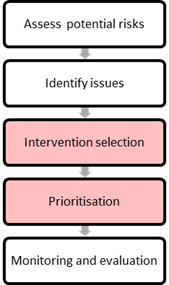11.1 INTRODUCTION
Once risk locations have been identified, and relevant information analysed to identify the likely causes, there is a need to select interventions and prioritise these for action. Figure 11.1 shows how these fit within the Road Infrastructure Safety Management process.

There is a cost associated with every road safety infrastructure intervention. Every country has a limited budget available to improve road safety therefore it is important to ensure that reductions in deaths and serious injuries are maximised within the budget available. This requires good knowledge about the effectiveness of road safety interventions in different circumstances. It also requires a process to help prioritise the implementation of safety treatments. Interventions are individual and collective actions that are taken to address risk. The terms ‘countermeasures’ or ‘treatments’ are also used.
This chapter provides information on the selection and prioritisation of effective road safety engineering interventions. It provides advice on the types of available options, and the process and tools that can be used to decide upon the most appropriate options. Intervention options and selection are outlined in Section 11.3 Intervention Options and Selection. In order to maximise safety outcomes, a priority ranking method is required, and this is typically based on economic assessment. This process is described in Section 11.4 Priority Ranking Methods and Economic Assessment. Once the priorities have been ranked, the cut-off for implementation of schemes is necessarily governed by the available budget and the main crash reduction target.
There are several guidelines which show some specific road safety problems and related crash types that contribute most to death and serious injuries. Some of these are aimed at addressing problems in LMICs, and also provide information on effective interventions. These include:
- The World Health Organization (WHO) has produced a guide to addressing pedestrian safety and crashes involving this road user group (WHO, 2013).
- The Asia-Pacific Economic Cooperation (APEC) has published guidance on addressing motorcycle crashes in their compendium of best practice (Haworth et al., 2010). This tool is a very useful source of information, including advice on effective interventions for those in LMICs who are experiencing crashes of this type.
- ‘Towards Safer Roads in Developing Countries’, produced by TRL (1991) provides very useful information targeted at those in LMICs on effective safety treatments.
- The Global Road Safety Partnership (GRSP) has produced a guide on addressing speed-related crashes (GRSP, 2023).
PIARC has produced a guide to saving lives around the world with proven countermeasure (PIARC, 2023). The countermeasures highlighted in this guide are notable because they have proven track records of success in multiple countries. Issues and priorities of low- and middle-income countries (LMICs) were inputs used to determine the list of proven countermeasures.
The Global Road Safety Facility (GRSF) has developed an evidence-based guide on ‘what works and what does not work’ in road safety in response to the critical need for effective evidence-based solutions (Turner et al., 2021). The guide offers a range of recommendations with a focus on interventions in LMICs, although the information may also be of relevance to all countries.
There are other documents that provide more general advice for these and other key crash types (i.e. they are not specifically targeted at the issues in LMICs). Some of these documents are freely accessible and provide guidance on the following issues.
Run-off-road interventions:
- United States: NCHRP Report 500 Volume 06: A Guide for Addressing Run-Off-Road Collisions (Neuman et al., 2003a).
- Australia: Road Safety Engineering Risk Assessment Part 10: Rural Run-off-road Crashes (Austroads, 2010d).
Intersection crashes:
- United States: NCHRP Report 500 Volume 05: Volume 12: A Guide for Reducing Collisions at Signalized Intersections (Antonucci et al., 2004) and FHWA’s Signalized Intersections: Informational Guide (FHWA, 2004).
- Australia: Road Safety Engineering Risk Assessment Part 9: Rural Intersection Crashes (Austroads, 2010c).
- New Zealand: High-risk intersections guide (NZTA, 2013b).
Head-on crashes:
- United States: NCHRP 500 Volume 04: A Guide for Addressing Head-On Collisions (Neuman et al., 2003b) and Volume 20: A Guide for Reducing Head-On Crashes on Freeways (Neuman et al., 2008).
- Australia: Road Safety Engineering Risk Assessment Part 8: Rural Head-on Crashes (Austroads, 2010b).
The European Road Safety Observatory (ERSO) also maintains an online repository of thematic reports. These reports provide road safety practitioners with qualitative analysis and an overview of the latest research on specific topics.
Many other documents can be accessed via the Internet from a variety of sources on these and other crash types. However, care should be taken to ensure that documents accessed from this source have been produced by reputable agencies, and that they provide robust information. Other documents exist that provide advice on a range of crash types and appropriate interventions in an easy-to-access format. Key documents are listed later in this chapter.
How do I get started?
The most cost-effective interventions to target key crash problems are well known. As a starting point, these interventions should be implemented in a targeted way on high-risk routes. These include:
- Adequate driver information (markings, channelization and signage).
- Nighttime lighting.
- Location to safely perform enforcement activities.
- Footpaths and safe crossing points for pedestrians.
- Separation for the most vulnerable user, pedestrians, motorcycles and bicycles.
- Adequate provision of safety for intersections (grade separation at the highest volume locations; roundabouts; raised platforms).
- Median barriers for higher volume, high speed roads.
- Roadside protection for high-speed roads.
- Effective speed management to reduce likely impact speeds to survivable levels.
An ideal starting point is to implement multi-sector (e.g. including policing and education programmes) demonstration projects on high-risk corridors utilising these effective interventions. For those just starting, this is a useful way to ‘learn by doing’ in a way that is easy to manage.
Economic assessment procedures need to be established, and key staff trained in this process. This will help effectively prioritise limited budgets. It will also help prepare an adequate business case for investing in road safety.






